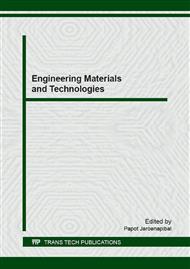[1]
M. Schwartz, Ceramic joining. Materials Park, Ohio: ASM International. (1990).
Google Scholar
[2]
K. Suganuma, Joining Ceramics and Metals. In: Handbook of Advanced Ceramics: Materials, Applications, Processing, and Properties: Second Edition, (2013).
Google Scholar
[3]
M. Schwartz, Ceramic joining. Materials Park, Ohio: ASM International; (1990).
Google Scholar
[4]
Thanee Toomprasen, Chawalit Thinvongpituk, Sukangkana Talangkun, The study on the properties of AISI 4140 and AISI 1040 steel rods welded by friction welding, KKU EN J. 41 (2014) 182-91. (in Thai).
Google Scholar
[5]
MN. Ahmad Fauzi, MB. Uday, H. Zuhailawati, AB. Ismail, Microstructure and mechanical properties of alumina-6061 aluminum alloy joined by friction welding, Mater Des. (2010).
DOI: 10.1016/j.matdes.2009.08.019
Google Scholar
[6]
MB. Uday, MN. Ahmad-Fauzi, AM. Noor, S. Rajoo, An insight into microstructural evolution during plastic deformation in AA6061 alloy after friction welding with alumina-YSZ composite, Mech Mater. (2015).
DOI: 10.1016/j.mechmat.2015.07.010
Google Scholar
[7]
K. Suganuma, Y. Miyamoto & M. Koizumi, Joining of ceramics and metals, Annual Review of Materials Science. 18. 1 (1988) 47-73.
DOI: 10.1146/annurev.ms.18.080188.000403
Google Scholar
[8]
A. Wu, Ceramic/metal bonding, Microjoining and nanojoining. (2008) 758–85.
DOI: 10.1533/9781845694043.3.758
Google Scholar
[9]
T. Mingmuang, S. Lee, C. Thinvongpituk, Mechanical properties of aluminium-alumina welding by friction welding, AMR. 418-420 (2011) 1279-1287.
DOI: 10.4028/www.scientific.net/amr.418-420.1279
Google Scholar
[10]
N. Özdemir, Investigation of the mechanical properties of friction-welded joints between AISI 304L and AISI 4340 steel as a function rotational speed, Mater Lett. (2005).
DOI: 10.1016/j.matlet.2005.03.034
Google Scholar
[11]
T. Sakai, A. Belyakov, R. Kaibyshev, H. Miura, J. Jonas, Dynamic and post-dynamic recrystallisation under hot, cold and severe plastic deformation conditions, Progress in Materials Science, 60 (2014) 130-207.
DOI: 10.1016/j.pmatsci.2013.09.002
Google Scholar
[12]
M. Schwartz, Metals joining manual, New York: McGraw-Hill; (1979).
Google Scholar
[13]
JR. Cho, WB. Bae, WJ. Hwang, P. Hartley, A study on the hot-deformation behavior and dynamic recrystallisation of Al ± 5 wt. % Mg alloy, Science (80- ) 118 (2001) 356–61.
DOI: 10.1016/s0924-0136(01)00978-5
Google Scholar
[14]
S. Gibson, Advanced welding, Basingstoke: Macmillan, (1997).
Google Scholar
[15]
W. Mengjun, G. Chunlei, L. Xinyu, Deformation behavior of 6063 aluminum alloy during high-speed compression, J Wuhan Univ Technol-Mat Sci Edit. 20 (2005) 40-43.
DOI: 10.1007/bf02835023
Google Scholar


